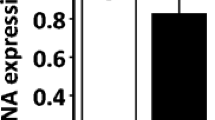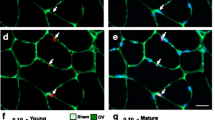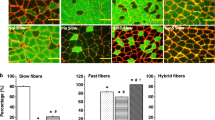Abstract
We addressed the question of whether hypertrophy induced by compensatory overload differs according to innervation status, and how fibroblast growth factors (FGF) and hepatocyte growth factor (HGF) mRNAs are expressed in the rat plantaris muscle during overload (OL) and/or denervation. Male Wistar rats were divided into four groups (Normal-Cont, Normal-OL, Denervated-Cont, and Denervated-OL). according to the plantaris denervation and/or overload. Three weeks later, plantaris weight in Denervated-Cont and Denervated-OL was significantly lower than in the Normal-Cont. The muscle weights in the Normal-OL were higher than in the Normal-Cont. The muscle weights in the Denervated-OL were higher than in the Denervated-Cont. Three days after the treatment, FGF-2, FGF-6, FGF-7 and HGF mRNAs in the Normal-OL were significantly higher than those in the Normal-Cont. FGF-2, FGF-6, FGF-7 and HGF mRNAs in the Denervated-OL were also significantly higher after 3 days than those in the Denervated-Cont. After 7 days, FGF-2, FGF-5, FGF-6, FGF-7 and HGF mRNAs were significantly higher in the Normal-OL than those in the Normal-Cont. At 21 days, FGF-1, FGF-6 and HGF mRNA levels were significantly increased. In the Denervated-OL, FGF-2, FGF-7 and HGF mRNAs at 7 days, and FGF-2 mRNA at 21 days were significantly higher than those in the Denervated-Cont. FGF-2 and FGF-6 mRNA levels decreased significantly following denervation; however, FGF-1, FGF-5, FGF-7 and HGF mRNA levels increased and maintained this increase for the 21-days treatment period. Muscle hypertrophy was thus induced by compensatory overload irrespective of innervation status, possibly in association with certain FGFs and HGF. The differential mRNA expression patterns of FGFs and HGF observed following compensatory overload and/or denervation suggest distinct roles for individual FGFs and HGF in muscle hypertrophy and/or atrophy.







Similar content being viewed by others
References
Allen RE, Rankin LL (1990) Regulation of satellite cells during skeletal muscle growth and development. Proc Soc Exp Biol Med 194:81–86
Alway SE, Gonyea WJ, Davis ME (1990) Muscle fiber formation and fiber hypertrophy during the onset of stretch-overload. Am J Physiol 259:C92–C102
Antonio J, Gonyea WJ (1993) Role of muscle fiber hypertrophy and hyperplasia in intermittently stretched avian muscle. J Appl Physiol 74:1893–1898
Bischoff R (1997) Chemotaxis of skeletal muscle satellite cells. Dev Dyn 208:505–515
Chomczynski P, Sacchi N (1987) Single step method of RNA isolation by guanidium thiocyanate-phenol-chloroform extraction. Anal Biochem 162:156–159
Dedkov EI, Kostrominova TY, Borisov AB, Carlson BM (2001) Reparative myogenesis in long-term denervated skeletal muscles of adult rats results in a reduction of the satellite cell population. Anat Rec 263:139–154
Fallon JF, López A, Ros MA, Savage MP, Olwin BB, Simandl BK (1994) FGF-2: apical ectodermal ridge growth signal for chick limb development. Science 264:104–106
Floss T, Arnold H-H, Braun T (1997) A role for FGF-6 in skeletal muscle regeneration. Gene Dev 11:2040–2051
Gal-Levi R, Leshem Y, Aoki S, Nakamura T, Halevy O (1998) Hepatocyte growth factor plays a dual role in regulating skeletal muscle satellite cell proliferation and differentiation. Biochim Biophys Acta 1402:39–51
Girlanda P, Dattola R, Vita G, Oteri G, Presti FL, Messina C (1982) Effect of electrotherapy on denervated muscles in rabbits: an electrophysiological and morphological study. Exp Neurol 77:483–491
Golde TE, Estus S, Usiak M, Younkin LH, Younkin SG (1990) Expression of ß amyloid protein precursor mRNAs: recognition of a novel alternatively spliced form and quantitation in Alzheimer’s disease using PCR. Neuron 4:253–267
Gorza L, Gundersen K, Lomo T, Schiaffino S, Westgaard RH (1988) Slow-to-fast transformation of denervated soleus muscles by chronic high-frequency stimulation in the rat. J Physiol (Lond) 402:627–649
Gulati AK (1988) Long-term retention of regenerative capability after denervation of skeletal muscle, and dependency of late differentiation on innervation. Anat Rec 220:429–434
Hannon K, Smith II CK, Bales KR, Santerre RF (1992) Temporal and quantitative analysis of myogenic regulatory and growth factor gene expression in the developing mouse embryo. Dev Biol 151:137–144
Hannon K, Kudla AJ, McAvoy MJ, Clase KL, Olwin BB (1996) Differentially expressed fibroblast growth factors regulate skeletal muscle development through autocrine and paracrine mechanisms. J Cell Biol 132:1151–1159
Kästner S, Rivera AJ, Yablonka-Reuveni Z (2000) Gene expression patterns of the fibroblast growth factors and their receptors during myogenesis of rat satellite cells. J Histochem Cytochem 48:1079–1096
Kuschel R, Yablonka-Reuveni Z, Bornemann A (1999) Satellite cells on isolated myofibers from normal and denervated adult rat muscle. J Histochem Cytochem 47:1375–1383
Li SG, Anderson R, Reginelli AD, Muneoka K (1996) FGF-2 influences cell movements and gene expression during limb development. J Exp Zool 274:234–247
Lu D-X, Huang S-K, Carlson BM (1997) Electron microscopic study of long-term denervated rat skeletal muscle. Anat Rec 248:355–365
McGeachie JK (1989) Sustained cell proliferation in denervated skeletal muscle of mice. Cell Tiss Res 257:455–457
McGeachie J, Allbrook D (1978) Cell proliferation in skeletal muscle following denervation or tenotomy. Cell Tiss Res 193:259–267
Mitchell P, Steenstrup T, Hannon K (1999) Expression of fibroblast growth factor family during postnatal skeletal muscle hypertrophy. J Appl Physiol 86:313–319
Murray MA, Robbins N (1982) Cell proliferation in denervated muscle: time course, distribution and relation to disuse. Neuroscience 7:1817–1822
Niederle B, Mayr R (1978) Course of denervation atrophy in type I and type II fibres of rat extensor digitorum longus muscle. Anat Embryol 153:9–21
Pachter BR, Eberstein A, Goodgold J (1982) Electrical stimulation effect on denervated skeletal myofibers in rats: a light and electron microscopic study. Arch Phys Med Rehabil 63:427–430
Phelan JN, Gonyea WJ (1997) Effect of radiation on satellite cell activity and protein expression in overloaded mammalian skeletal muscle. Anat Rec 247:179–188
Rando TA, Blau HM (1994) Primary mouse myoblast purification, characterization, and transplantation for cell-mediated gene therapy. J Cell Biol 125:1275–1287
Rodrigues ADC, Schmalbruch H (1995) Satellite cells and myonuclei in long-term denervated rat muscles. Anat Rec 243:430–437
Rosenblatt JD, Parry DJ (1992) Gamma irradiation prevents compensatory hypertrophy of overloaded mouse extensor digitorum longus muscle. J Appl Physiol 73:2538–2543
Saitoh A, Okumoto T, Nakano H, Wada M, Katsuta S (1999) Age effect on expression of myosin heavy and light chain isoforms in suspended rat soleus muscle. J Appl Physiol 86:1483–1489
Sakuma K, Watanabe K, Totsuka T, Uramoto I, Sano M, Sakamoto K (1998) Differential adaptations of insulin-like growth factor-I, basic fibroblast growth factor, and leukemia inhibitory factor in the plantaris muscle of rats by mechanical overloading: an immunohistochemical study. Acta Neuropathol 95:123–130
Sakuma K, Watanabe K, Sano M, Uramoto I, Totsuka T (2000) Differential adaptation of growth and differentiation factor 8/myostatin, fibroblast growth factor 6 and leukemia inhibitory factor in overloaded, regenerating and denervated rat muscles. Biochim Biophys Acta 1497:77–88
Schmalbruch H, Lewis DM (2000) Dynamics of nuclei of muscle fibers and connective tissue cells in normal and denervated rat muscles. Muscle Nerve 23:617–626
Schmalbruch H, Al-Amood WS, Lewis DM (1991) Morphology of long-term denervated rat soleus muscle and the effect of chronic electrical stimulation. J Physiol (Lond) 441:233–241
Schultz E, McCormick KM (1994) Skeletal muscle satellite cells. Rev Physiol Biochem Pharmacol 123:213–257
Snow MH (1990) Satellite cell response in rat soleus muscle undergoing hypertrophy due to surgical ablation of synergists. Anat Rec 227:437–446
Spector SA (1985) Trophic effects on the contractile and histochemical properties of rat soleus muscle. J Neurosci 5:2189–2196
Szebenyi G, Fallon JF (1999) Fibroblast growth factors as multifunctional signaling factors. Int Rev Cytol 185:45–106
Tatsumi R, Sheehan SM, Iwasaki H, Hattori A, Allen RE (2001) Mechanical stretch induces activation of skeletal muscle satellite cells in vitro. Exp Cell Res 267:107–114
Timson BF (1990) Evaluation of animal models for the study of exercise-induced muscle enlargement. J Appl Physiol 69:1935–1945
Vandenburgh HH, Hatfaludy S, Karlisch P, Shansky J (1989) Skeletal muscle growth is stimulated by intermittent stretch-relaxation in tissue culture. Am J Physiol 256:C674–C382
Viguie CA, Lu D-X, Huang S-K, Rengen H, Carlson RM (1997) Quantitative study of the effects of long-term denervation on the extensor digitorum longus muscle of the rat. Anat Rec 248:346–354
Webb SE, Lee KKH, Tang MK, Ede DA (1997) Fibroblast growth factors 2 and 4 stimulate migration of mouse embryonic limb myogenic cells. Dev Dyn 209:206–216
Winchester PK, Davis ME, Alway SE, Gonyea WJ (1991) Satellite cell activation in the stretch-enlarged anterior latissimus dorsi muscle of the adult quail. Am J Physiol 260:C206–C212
Yamaguchi A, Ikeda Y, Hirai T, Fujikawa T, Morita I (2003) Local changes of IGF-I mRNA, GH receptor mRNA and fiber size in rat plantaris muscle following compensatory overload. Jpn J Physiol 53:53–60
Yang S, Alnaqeeb M, Simpson H, Goldspink G (1997) Changes in muscle fibre type, muscle mass and IGF-I gene expression in rabbit skeletal muscle subjected to stretch. J Anat 190:613–622
Author information
Authors and Affiliations
Corresponding author
Rights and permissions
About this article
Cite this article
Yamaguchi, A., Ishii, H., Morita, I. et al. mRNA expression of fibroblast growth factors and hepatocyte growth factor in rat plantaris muscle following denervation and compensatory overload. Pflugers Arch - Eur J Physiol 448, 539–546 (2004). https://doi.org/10.1007/s00424-004-1282-5
Received:
Accepted:
Published:
Issue Date:
DOI: https://doi.org/10.1007/s00424-004-1282-5




